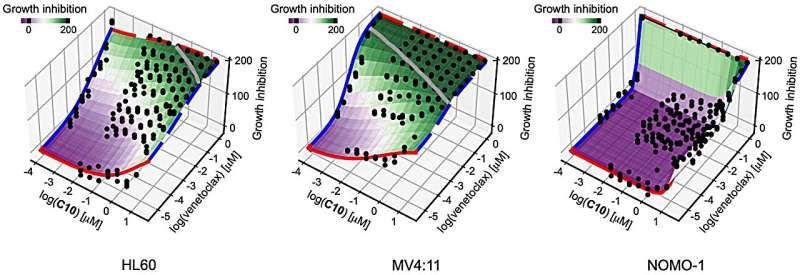This article has been reviewed according to Science X's editorial process and policies. Editors have highlighted the following attributes while ensuring the content's credibility:
fact-checked
peer-reviewed publication
trusted source
proofread
Promising drug-like compounds found to have strong action against blood cancers

For researchers, projects can sometimes feel like babies, and there is nothing more satisfying than seeing your baby grow up. For William Tansey, professor of cell and developmental biology, this baby started 10 years ago when he and Stephen Fesik, Orrin H. Ingram II, Professor of Cancer Research and professor of biochemistry, discovered that a protein called WDR5 is a "partner in crime" to MYC, a transcription factor and oncogene that is often mutated in cancers. In fact, dysregulation of MYC is estimated to be responsible for about a third of all cancer deaths annually.
This research baby is growing up fast. Tansey, Fesik, and other researchers around the world have produced hundreds of papers on WDR5 in the last five years alone. Among the findings: WDR5 recruits MYC to chromatin to control the expression of genes that cancer cells use to make the proteins they need to thrive. Thus, WDR5 is an excellent drug target candidate to treat MYC-related cancers.
Previous Tansey and Fesik research resulted in the discovery of WDR5 inhibitors called WIN-site inhibitors, or WINi. WINi have only been shown to be active against a handful of rare cancer types. But, for their most recent paper, Tansey recruited Vito Quaranta, professor emeritus of pharmacology, to help analyze a panel of 300 cancer cell lines derived from 20 different cancer types for sensitivity to WINi.
Their latest work, published in the Proceedings of the National Academy of Science, shows that blood cancers are particularly sensitive to the effects of WINi and that combining WINi with venetoclax improves the drug's efficacy in suppressing leukemia progression in an animal model; venetoclax is a Food and Drug Administration–approved drug to used treat acute myeloid leukemia.
Synergy between WINi and venetoclax means that clinicians might be able to reduce the dose of venetoclax needed for treatment, thereby reducing its side effects while potentially improving outcomes for leukemia patients.
Quaranta was not the only other collaborator who was brought on board for this project. "Collaborating with Qi Liu helped us understand the mechanism of action of combining our inhibitors with venetoclax. Collaborating with Michael Savona enabled us to show that our inhibitors were effective when combined with venetoclax," Tansey said. Liu is a professor of biostatistics and Savona a professor of medicine.
"This is a very home-grown story," Tansey said. "I am grateful we have such a variety of world-class experts here that we can work with to get such robust research done." Tansey also worked with April Weissmiller of Middle Tennessee State University, William Moore of the National Cancer Institute, and Gordon Stott from the Frederick National Laboratory for Cancer Research for this paper.
For now, this research baby's potential is multiplying. "Before this work, we expected future drugs to have only limited clinical utility," Tansey said, referring to previous findings that indicated that WINi were active only against a handful of rare cancer types.
"Our finding that leukemia and lymphoma cells have broad sensitivity to WINi, both in vitro and in vivo, represents a significant expansion in the number of cancer instances that could benefit from WINi in the clinic."
Blood-borne cancers—leukemias, lymphomas, and myelomas—represent about 10% of all cancers diagnosed in the U.S. annually and are responsible for about 3% of annual cancer deaths.
The authors of the paper noted that some solid cancer cell lines, particularly those derived from ovarian and breast cancers, were also sensitive to WINi in the cell-based studies, a finding that constitutes a yet-unexplored area of research.
Both types of cancer present a significant disease burden in the United States: Breast cancer is the second most common type of cancer in women and ovarian is the second most common type of gynecologic cancer in women. Additionally, breast cancer and ovarian cancer are closely related, and a breast cancer diagnosis increases the risk of having ovarian cancer and vice versa.
Targeting blood, breast, and ovarian cancers means that WINi have tremendous potential. But before they can help patients, Tansey said, "These studies will help us know how WINi can be applied in the clinic and how to get the most out of them for ameliorating hematologic malignancies."
In the meantime, he added, "the National Cancer Institute is working with us to develop these inhibitors into drugs."
More information: Christian T. Meyer et al, Expanded profiling of WD repeat domain 5 inhibitors reveals actionable strategies for the treatment of hematologic malignancies, Proceedings of the National Academy of Sciences (2024). DOI: 10.1073/pnas.2408889121


















